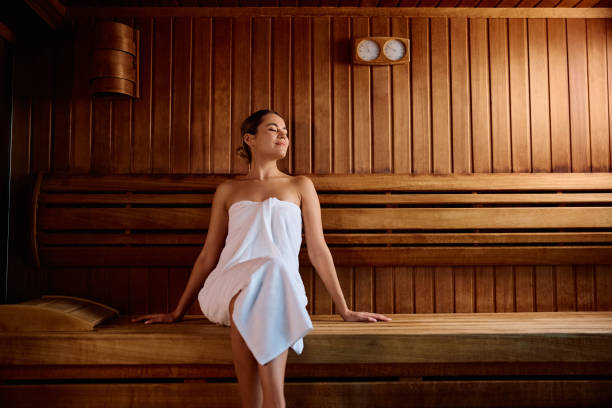Understanding House Saunas and How They Work
House saunas have been part of daily life in many cultures for centuries, offering a warm place to relax and enjoy quiet time. This article explains how saunas are built, the different styles used at home, and the simple process that makes the room warm. It also explores the traditions that shaped saunas, how they became common in modern homes, and what makes each type unique. By the end, readers will understand how saunas function and why they continue to be a popular part of home design today.

Installing a sauna in your home transforms your living space into a personal wellness retreat. House saunas provide a convenient way to enjoy regular heat therapy sessions without visiting commercial facilities. Modern home saunas range from traditional wood-fired models to contemporary infrared units, each offering unique experiences and benefits. The growing interest in home wellness has made saunas more accessible and affordable than ever before, with options suitable for various home sizes and budgets.
What Are the Main House Sauna Benefits?
Regular sauna use offers numerous physical and mental health advantages. Heat exposure promotes relaxation by reducing muscle tension and stress levels, making saunas excellent for post-workout recovery or unwinding after long days. The elevated temperatures increase circulation, which may support cardiovascular health when used responsibly. Sweating helps the body eliminate toxins and can improve skin appearance by opening pores and promoting cleansing. Many users report better sleep quality after evening sauna sessions, as the cooling process that follows heat exposure naturally prepares the body for rest. Beyond physical benefits, the quiet, warm environment provides a meditative space for mental clarity and stress relief. However, individuals with certain health conditions should consult healthcare professionals before beginning regular sauna use.
This article is for informational purposes only and should not be considered medical advice. Please consult a qualified healthcare professional for personalized guidance and treatment.
What Are the Different Types of Home Saunas?
Home saunas fall into several categories, each with distinct characteristics. Traditional Finnish saunas use electric or wood-burning heaters to warm the air, typically reaching temperatures between 150-195°F. These saunas often include rocks that can be splashed with water to create steam and adjust humidity levels. Infrared saunas use light waves to directly heat the body rather than the surrounding air, operating at lower temperatures around 120-140°F while still inducing sweating. These units typically consume less energy and require less installation complexity. Steam rooms, though technically different from dry saunas, create high-humidity environments at moderate temperatures. Barrel saunas offer outdoor installation options with distinctive aesthetic appeal and efficient heat circulation due to their curved design. Portable saunas provide budget-friendly, space-saving alternatives that can be set up and stored as needed, though they offer a different experience than permanent installations.
How Do Saunas Work to Generate Heat?
The mechanics behind sauna operation vary by type but share the common goal of elevating body temperature. Traditional saunas rely on heating elements or wood fires to warm the air inside an insulated enclosure. The heated air then transfers warmth to occupants through convection and conduction. Sauna rocks store thermal energy and release it gradually, maintaining consistent temperatures and allowing for steam generation when water is applied. Proper ventilation systems ensure fresh air circulation while maintaining heat levels. Infrared saunas function differently, using infrared panels that emit light waves absorbed directly by skin and tissue. This direct heating method penetrates deeper into the body at lower ambient temperatures, which some users find more comfortable. Both systems require insulated walls, typically constructed from wood species like cedar or hemlock that withstand high temperatures and moisture while providing pleasant aromas. Temperature controls and timers allow users to customize their sessions safely.
What Does a Sauna Installation Guide Include?
Installing a home sauna requires careful planning and consideration of several factors. Location selection depends on available space, access to electrical connections, and ventilation requirements. Indoor installations need adequate floor support, as saunas can be heavy, plus proximity to plumbing if you plan to include a shower nearby. Electrical requirements vary significantly; traditional electric saunas often need dedicated 240-volt circuits, while infrared models may operate on standard 120-volt outlets. Professional electricians should handle wiring to ensure safety and code compliance. Ventilation planning prevents moisture damage to surrounding areas and ensures comfortable air quality inside the sauna. Most installations require intake vents near the floor and exhaust vents near the ceiling to facilitate proper air circulation. Flooring should be water-resistant and heat-tolerant, with options including tile, sealed concrete, or specially treated wood. Prefabricated sauna kits simplify installation for DIY enthusiasts, while custom-built saunas offer tailored dimensions and features but require more extensive construction expertise.
What Are Key Elements of Home Sauna Design?
Effective home sauna design balances functionality, aesthetics, and space efficiency. Size considerations depend on intended users; a two-person sauna typically requires about 4x4 feet of floor space, while larger family units may need 6x8 feet or more. Ceiling height should accommodate comfortable seating, usually around 6-7 feet. Bench configuration affects the sauna experience significantly; tiered benches allow users to choose their preferred heat intensity, as temperature increases with elevation. Wood selection impacts both appearance and performance; cedar resists moisture and insects while providing pleasant aromatics, hemlock offers a lighter color with minimal scent, and aspen remains cool to the touch even at high temperatures. Lighting should be heat-resistant and create a relaxing ambiance, with many designs incorporating LED fixtures behind wooden slats for indirect illumination. Glass doors or windows can make smaller saunas feel more spacious, though traditional designs favor solid wood construction for better heat retention. Climate control features, including digital thermostats and humidity monitors, enhance user comfort and safety.
Conclusion
House saunas represent a valuable investment in personal wellness and home comfort. Understanding the different types available, how they generate therapeutic heat, and what installation and design considerations matter most enables homeowners to select options that align with their needs and spaces. Whether you choose a traditional Finnish sauna for authentic heat experiences or an infrared model for energy efficiency and ease of installation, regular sauna use can enhance your quality of life. Careful planning during the installation phase ensures your sauna operates safely and efficiently for years to come, providing a private sanctuary for relaxation and health benefits right in your own home.




